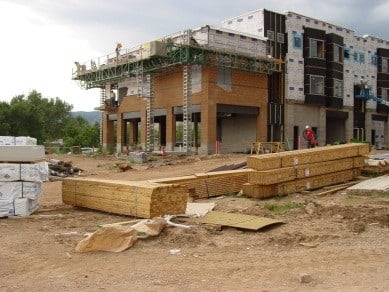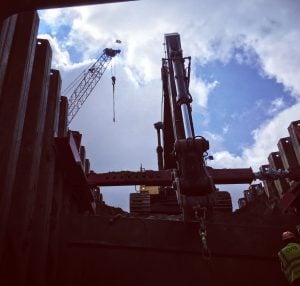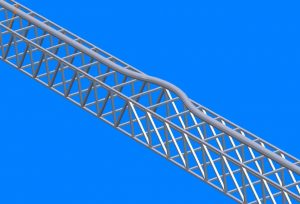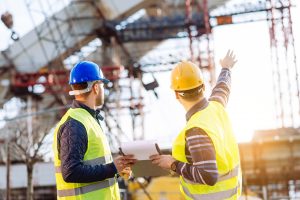Aerial Work Platforms (AWP) are wonderful machines. They provide quick elevated access for workers to perform their tasks. They are mobile and safe to use. But how do they work? Why don’t they fall over? Well, they do fall over but it isn’t the machine’s fault—it’s the guy who forgot his training and screwed up.
Aerial Work Platforms encompass the various machines that are addressed in the 92 series of standards promulgated by the American National Standards Institute (ANSI). For example, these standards include Boom Supported Elevating Work Platforms (Boom Lifts), Self-Propelled Elevating Work Platforms (Scissors Lifts), Vehicle-Mounted Bridge Inspection and Maintenance Devices and Mast Climbers. Although the ANSI 92 series standards also address other machines, this article will focus on the engineering magic of boom lifts, scissors lifts, and mast climbers.
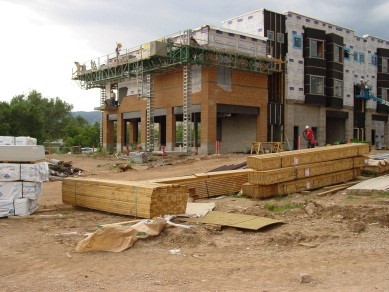 Mast Climber
Mast Climber
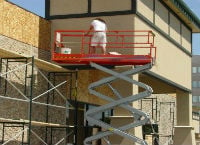 Scissors Lift
Scissors Lift
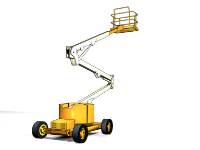 Boom Lift
Boom Lift
While each of these three machines provides a platform that elevates, each machine does it best for specific conditions. For example, while a boom lift can provide access to the same locations as a scissors lift, a scissors lift typically can provide a larger platform. A scissors lift can provide access similar to a mast climber but a mast climber can support heavier loads and take the platform to a much higher elevation. However, in spite of these variations, the underlying engineering principles are the same.
Issues to Consider
When it comes to AWPs, the designer needs to address specific issues unique to the machine that is being designed while also addressing issues common to all machines. The most obvious issue is the strength of the machine. Each machine must be designed to support a certain load if it is expected to be functional. This load could be limited to one worker or it could be maximized to support heavy material loads such as pallets of brick or block. Typically steel is used as the material of choice for the load bearing elements, augmented by other materials chosen by the designer based on weight, economics, esthetics and suitability.
Stability is as important as strength. After all, what good is the elevated platform if it continues to fall over when you use it? In fact, the engineering property called the “center of gravity” should be of great concern to the designer as well as the user. Any AWP will do well provided the Center of Gravity (CofG) stays within the confines of the base of the machine. Once the CofG moves outside the base of the machine the operator will have a rather disconcerting experience if not a deadly one.
The CofG and its location are determined by the weight of the machine and the loads placed on the machine. As an illustration, picture a cube of concrete, or Styrofoam® (if you want to be a lightweight) that is 24 inches wide by 24 inches long by 24 inches high. The CofG is exactly in the center of the cube, 12 inches from each side. Now, place a six-pack of your favorite beverage on one edge of the cube. The CofG will shift towards the side of the cube where the six-pack is. Place it on the corner and the CofG will shift towards the corner. It will not shift all the way to the corner since the weight of the concrete is much greater than the six-pack, especially if you drank part of it! Now, since you drank all of the six-pack, place a twelve-pack at the opposite corner and the CofG will shift back past the center and towards the twelve-pack corner. The same phenomenon occurs in AWPs. For a scissors lift, the CofG easily stays within the wheelbase since the platform is never much bigger than the wheel base. However, for scissors lifts which have a cantilever platform, the CofG will shift towards the cantilever but will not move out of the wheelbase unless of course you stock the cantilever with enough six-packs to shift the CofG outside the wheelbase; now you have a problem – you just spilled your favorite beverage.
What about a boom lift where the basket is far from the wheelbase of the machine? Well, the CofG is still within the wheelbase because the designer made sure that no matter where you move the boom the CofG will never leave the wheelbase. Of course, should you overload the basket (that is loading it beyond the allowable load specified by the designer) or override the safety features that limit the boom extension, you will destabilize the boom resulting in some rather nasty results.
Mast Climbers operate under the same engineering restrictions but have another element that must be controlled. Since the platform is supported by a mast, the CofG must remain within the mast base. Because the mast base is typically rather small, like 2 feet by 2 feet, the mast must be supported at specific intervals to maintain the mast in plumb. Additionally, the platform loads must be carefully and continuously monitored to ensure the loads are balanced. That explains why there are loading charts on Mast Climber platforms.
Speaking of loads, boom lifts, mast climbers and scissors lifts must never be overloaded since the strength of the machine is based on the expected loads and the stability of the machine is based on the expected loads and use of the machine. Remember that overload does not mean collapse; it means that there is a safe load limit and anything above that will cause the machine to malfunction, stop working, fall over or fall down. None of these outcomes is healthy—believe what the manufacturer and the ANSI standards tell you!



